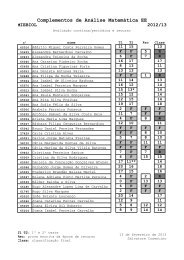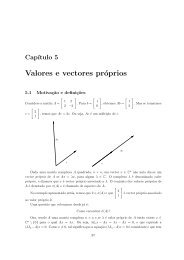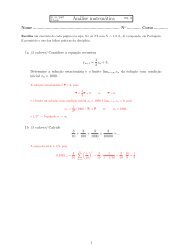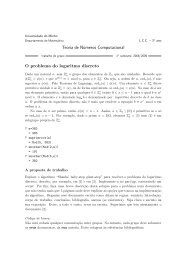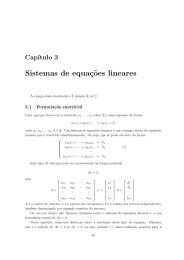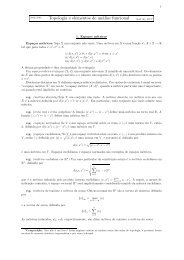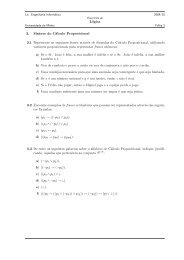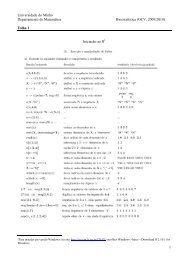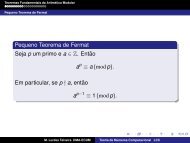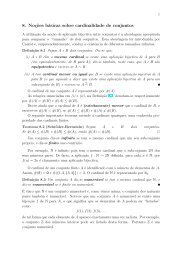My title - Departamento de Matemática da Universidade do Minho
My title - Departamento de Matemática da Universidade do Minho
My title - Departamento de Matemática da Universidade do Minho
Create successful ePaper yourself
Turn your PDF publications into a flip-book with our unique Google optimized e-Paper software.
6 FLOWS 41<br />
6.2 Integration of one-dimensional systems<br />
“6acc<strong>da</strong>e13eff7i3l9n4o4qrr4s8t12vx”<br />
(Data aequatione quotcunque fluentes quantitates involvente fluxiones invenire et vice<br />
versa)<br />
Isaac Newton, letter to Gottfried Leibniz, 1677.<br />
Some techniques to integrate ordinary differential equations (ODEs) like<br />
ẋ = v(x, t)<br />
when the phase space X ⊂ R is one or two-dimensional.<br />
Integrating simple ODEs. The simplest case occurs when the velocity field v <strong>do</strong>es not <strong>de</strong>pend<br />
on the phase space variable x, hence<br />
ẋ = v(t) ,<br />
where v(t) is some given (piecewise) continuous function of time. This just says that x must be a<br />
primitive of v, and the fun<strong>da</strong>mental theorem of calculus (i.e. Leibniz and/or Newton’s discovery)<br />
tells us how to compute such a primitive:<br />
∫ t<br />
x(t) = x 0 + v(s)ds .<br />
t 0<br />
Here you may observe that this class of ODEs have “symmetries”. The line field <strong>do</strong>es not <strong>de</strong>pend<br />
on x, hence slopes of solutions are the same along horizontal lines (t = constant) in the exten<strong>de</strong>d<br />
phase space X × R. There follows that any translate ϕ(t) + c of a solution ϕ(t) is still a solution.<br />
Autonomous first or<strong>de</strong>r ODEs and their flows.<br />
A first or<strong>de</strong>r ODE of the form<br />
ẋ = v(x) ,<br />
where the velocity field v <strong>do</strong>es not <strong>de</strong>pend on time, is called autonomous. Most fun<strong>da</strong>mental<br />
equations of physics (those <strong>de</strong>scribing closed systems, without external forces) can be written as<br />
autonomous first or<strong>de</strong>r ODEs, and this corresponds to time-invariance of physical laws.<br />
Here you may notice symmetries again. The line field v of an autonomous equation is constant<br />
along vertical lines (x = constant) of the exten<strong>de</strong>d phase space X ×R. Hence any translate ϕ(t+s)<br />
of a solution ϕ(t) is still a solution. This is the manifestation of time-invariance of a law codified<br />
by an autonomous ODE. This also implies that there is no loss of generality in restricting to an<br />
initial time t 0 = 0.<br />
Equilibrium solutions. First, we observe that an autonomous equation may admit constant<br />
solutions. In<strong>de</strong>ed, if x 0 is a singular point of the vector field v, i.e. a point where v(x 0 ) = 0, then<br />
the constant function<br />
x(t) = x 0 ∀ t ∈ R<br />
obviously solves the equation. Such solutions, which <strong>do</strong> not change with time, are called equilibrium,<br />
or stationary, solutions.<br />
Solutions near non-singular points. The trick used to “guess” other solutions, when the<br />
phase space is one-dimensional, i.e. X ⊂ R, is a first instance of the method of “separation of<br />
variables”. Fix a non-singular point of the velocity field, i.e. a point x 0 where v(x 0 ) ≠ 0. We<br />
want to solve the Cauchy problem with initial condition x(t 0 ) = x 0 . First, rewrite the equation<br />
dx/dt = v(x) formally as “dx/v(x) = dt” (multiply by dt and divi<strong>de</strong> by v(x), so that all x’s are<br />
on the left and all t’s are on the right). Instead of trying to make sense to this last expression<br />
(which is possible, of course, and here you can appreciate the beauty of Leibniz’ notation dx/dt for<br />
<strong>de</strong>rivatives!), observe that it is suggesting that ∫ dx/v(x) = ∫ dt. Now assume that the velocity<br />
field v is continuous and let J = (x − , x + ) be the maximal interval containing x 0 where v is different



